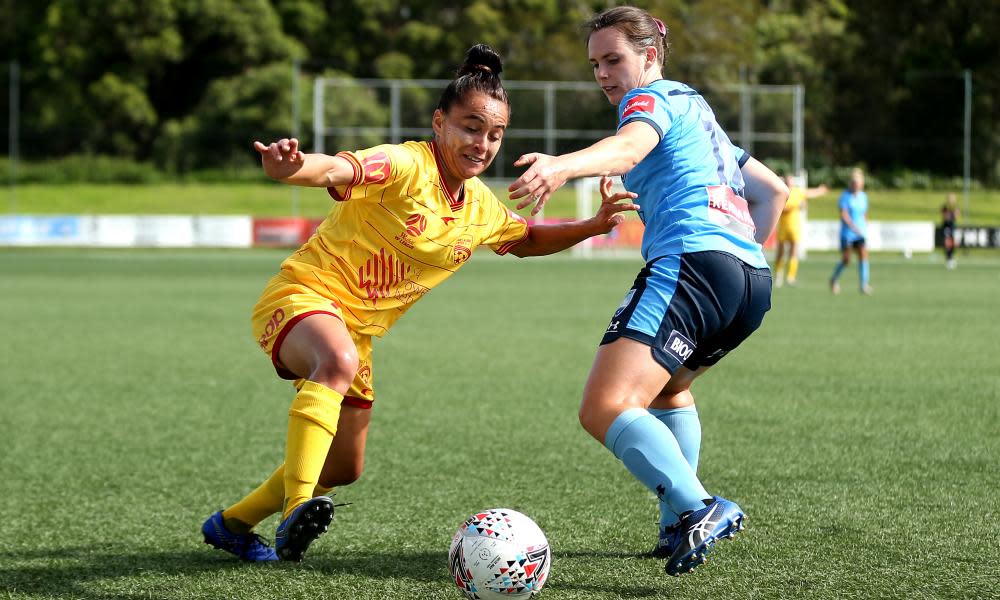Plastic not so fantastic: concerns raised over artificial W-League pitch

The first thing you noticed was the smell. Walking into Cromer Park for Sydney FC’s match against Adelaide United on Sunday, overpowering the usual wafts of hot chip boxes and the salty ocean breeze, was the burnt-rubber odour of its artificial pitch baking in the afternoon sun.
The turf did not just smell bad, though; it also looked and behaved poorly. The gangrenous green “grass” was stained with patches of black from the loose rubber pellets that sprayed up like dust with every kick, tackle and slide. The day’s heat made the field sticky in some places and slick in others, the ball’s unpredictable skip or spin forcing players to take extra touches. The game noticeably suffered as a result.
Related: How Football Australia plans to capitalise on hosting Women's World Cup | Samantha Lewis
Cromer Park in Sydney’s northern beaches is the only artificial field used in Australia’s top football competitions. It is also exclusively used in the W-League. While A-League teams have played on artificial surfaces during, for example, the FFA Cup, no official A-League game has ever been staged on one.
Over the last half-decade, artificial turf has become another space where the unequal treatment of men’s and women’s football has been made visible. In 2015, Fifa came under fire for allowing the Women’s World Cup in Canada to take place on several artificial surfaces while the men’s World Cup the previous year was played on natural grass.
US women’s national team forward Abby Wambach described artificial turf as “a nightmare” when photos surfaced of players with cuts and friction burns sustained while playing and training on them. Other images showed boots literally melting due to the rubber pitches overheating.
There are, of course, some positives to artificial pitches. While more expensive to install than natural grass, they are also cheaper to maintain, particularly in a changing climate. Indeed, environmental factors are accelerating the need for innovation in this area of the game, meaning better-quality artificial surfaces will likely be developed.
For now, though, W-League players must – as the cliche goes – play (on) what’s in front of them. And while Sydney FC full-back Ally Green is more familiar than most with Cromer Park, where she plays with Manly United in the winter, she said even she continues to struggle with its effects on her mind and body.
“It’s a lot harder; you physically pull up worse,” Green told Guardian Australia after Sydney’s 2-1 win over Adelaide. “This week we’ll probably be sore, and it’ll be a quick turn-around to fly to Perth and play on Thursday, but we’ll do our best to recover and do everything we can to get back and firing.
“It’s difficult to read sometimes, the ball is naturally going to bounce a lot more [so] you’ve got to be prepared to have it bounce up at you right at the last second. So yeah, it is a lot different, and it’s challenging when neither of the teams got to train on it before the game, either. It’s hard to get used to in the warm-up; you’re quickly adjusting to everything.
“After you’ve got slide burns, it’s quite tough to tackle and you do fall a lot harder. Even though it’s rubber and you bounce off with the ball, it’s not as nice when you’re falling on hot gravel. The rubber gets pretty hot under your feet, as well, especially with the sun on it.
“It is a bit unfair at the end of the day that we have to [play on artificial while the A-League does not], but a lot of the girls would rather play in a small stadium compared to a big stadium and double-header. So if we have to suck it up for this pitch, then we do.”
Cromer Park has rated poorly among W-League players for some time. In last season’s PFA season report, the artificial ground received the lowest overall quality rating out of any W-League stadium (1.5/5), with a high rating for “hardness” and below-average rating for “smoothness”.
This season, Cromer continues to rank poorly on the PFA’s pitch rating scale (3/5), with just two other pitches – Dorrien Gardens in Perth and Epping Stadium in Victoria – have rated lower (2/5).
When asked why W-League games were still staged at Cromer Park in light of this feedback, Sydney FC CEO Danny Townsend mirrored Green’s point that community engagement and match-day atmosphere also play a key role in ground choice.
“We’ve played at least one Westfield W-League game at Cromer Park for each of the past four years and we’ve always had fantastic support from the local community, which the players enjoy and thrive on,” he said. But he added that once the current surface is replaced later this year, a review will be undertaken as to which venues to play at in the future.
That would not only be a move towards providing women players with comfortable, consistent playing surfaces and ensuring their physical welfare, but also an important symbolic step in removing the many historic handicaps that have prevented the game and its players from flourishing. Sometimes, as Sunday’s game at Cromer Park illustrates, that process must start literally from the ground up.

 Yahoo News
Yahoo News 
